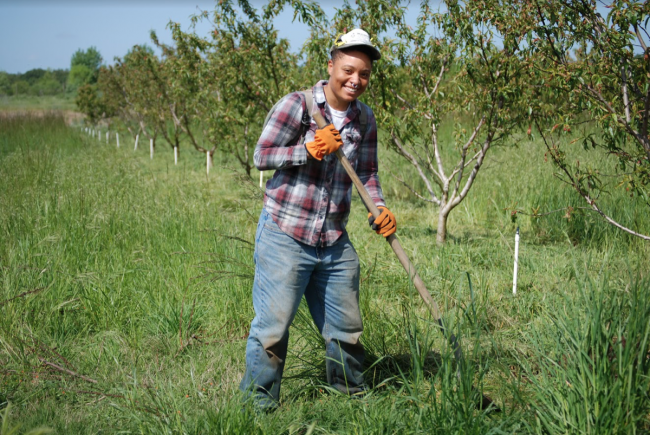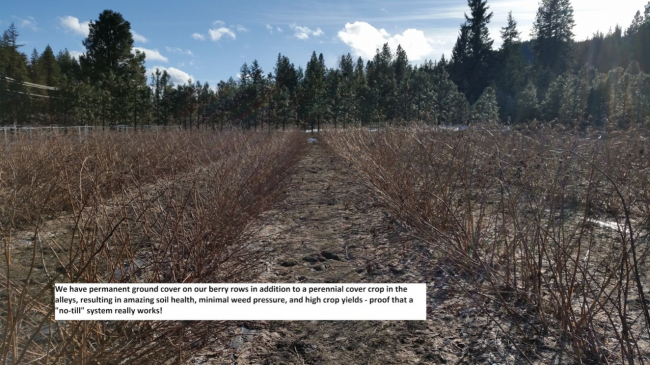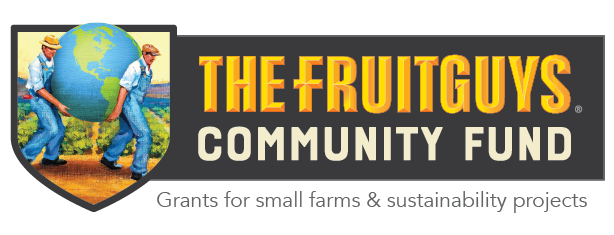At The FruitGuys Community Fund we look to fund ecologically sustainable projects. One of the projects that we’ve been proud to support is the transition to no-till agriculture. No-till gardening meets our criteria for good water management, good soil and air quality management, and climate change mitigation. One other great thing about no-till agriculture is that it’s a feasible project for gardeners to tackle at home as well.
What is No-Till Gardening?
No-till gardening is pretty much exactly what it sounds like. Farmers and gardeners using this method don’t till or turn their soil over. Instead they use other methods like broad forking, mulching, and cover cropping to prepare their gardens for planting. They then plant through a layer of existing plant material so the soil is never bare.

2017 grantee, Soil Born Farms, has increased organic matter and improved soil quality after moving toward a no-till system.
Benefits of No-Till
- Improves soil health.
Advances in science have taught us that there’s so much more to a productive garden than soil fertility. Soil is filled with microbes, fungi, and insects that help plants grow. Unfortunately when we turn soil over and disturb its natural layers many of these are killed. - Reduces erosion.
No-till gardening reduces soil erosion because the soil isn’t ever bare. When soil is left bare it’s easy for rain water to wash it away. Rather than tilling in a previous crop, it’s left on the field as a mulch and to help hold soil in place. - Reduces use of fossil fuels.
Going no-till means that fossil fuels aren’t used turning over the soil each year which is one of the most fuel intensive operations on a farm. - Improves soil structure.
No-till agriculture improves soil structure in a couple of ways. One of the key parts of creating good soil structure is the addition of organic matter which lightens soil, creates air spaces in the soil, and increases its capability to hold moisture. These are key to productive, healthy plants. Soil compaction through the use of heavy tractors and equipment is also avoided. - Reduces soil moisture loss.
In the same way that no-till gardening reduces erosion, it also reduces moisture loss. When the soil isn’t left bare less moisture will evaporate. - It can reduce the need for weeding.
If done properly no-till gardening can actually reduce the need for weeding. Cover crops and mulch or dead plant material block many weeds from sprouting up. - Improves crop yields.
No-till gardening has been found to increase crop yields. Improved soil and less moisture loss can create more productive gardens. - Reduces the amount of CO2 released into the atmosphere.
Using cover crops and keeping soils intact increases their ability to hold onto CO2.
Initial Drawbacks
While no-till has proven to be a great method in the longterm there can be a few initial drawbacks.
- For those with heavy wet spring soils tilling is often helpful in drying soil out to get crops in on time.
In a no-till garden the cover crop, mulch, or crop residue on the field helps hold moisture. While this is great during the height of summer it may not be desirable in early spring. However in the longterm no-till gardening can vastly improve soil structure which will help with drainage issues. - Depending on your situation there can be a few costs.
As you won’t be tilling each spring you’ll want to ensure your garden isn’t completely overtaken by weeds through the fall and winter. This means you either want to mulch your garden or better yet plant a cover crop. While the cost of cover crop seed or mulch isn’t enormous, especially for smaller gardens, it is something to consider.

With a $5K grant award 2018 grantee, Hope Mountain Farm will transition more fields to no-till.
How You Can Start a No-Till Garden
If you already have a garden one of the easiest ways you can transition to a no-till garden is to divide it into beds and pathways. You don’t have to build raised beds just designate areas. Not walking where you plant will reduce soil compaction and the need for tilling. Then whenever a crop is finished plant a cover crop or mulch the bed. When you’re ready to plant again you can cut your cover crop and use it as mulch. If you need to plant seed you can just rake or hoe the immediate planting area using leftover mulch and crop residue around your new plants to prevent weeds and keep them moist.
If you feel you need to till because you have heavy or compacted soils consider trying out a broad fork. With a broad fork you’re not turning over the soil you’re just lifting and loosening it. They’re easy to use and more affordable than a tiller.
For those who don’t already have an existing garden creating a no-till garden can seem like a daunting task. While some may opt to use a tiller to initially start a garden there is an easy way to go no-till from the very start. You can create a “lasagna garden.” First lay down a layer of brown cardboard, then a thick layer or hay or straw, then a thick layer of compost or soil. It’s an instant no-till garden. As the hay and cardboard rots they’ll provide more nutrients for your plants.
You don’t have to be a farmer to make a difference like The FruitGuys Community Fund grantees. Even for the backyard gardener going no-till can be a great project to help you create a more sustainable garden.




